The more I’ve been researching Kilimanjaro, and that’s almost two years now—initially to prepare my own climb, then to publish my book, and finally to fill this blog—the more frustrated I’ve been getting with the quality of content dispersed all over the Internet.
Initially new to Kilimanjaro, then new to social media, and finally new to blogging, it took me a while to figure out what’s going on. Here’s my current take on it, and why I’m ever more determined to do something about it:
Unfortunately, most people writing about Kilimanjaro are either biased or clueless!
1) Poor operators keep spreading misleading information disguised as tourists
I’ve been observing TripAdvisor forum posts for almost two years, and it’s very clear that many of them related to Kilimanjaro are not authentic. Often, those fake reviewers do not show their face on their profile picture (nor provide any other basic information about their identity), have never before written any reviews, and recommend little-known operators that are not listed amongst the KPAP Partners for Responsible Travel.
In all fairness, TripAdvisor has been trying to do something about it, and a lot of posts that don’t meet their guidelines are being removed on an ongoing basis. This is good news, and it explains why you will find many posts looking like the below when reading through Kilimanjaro reviews on TripAdvisor.
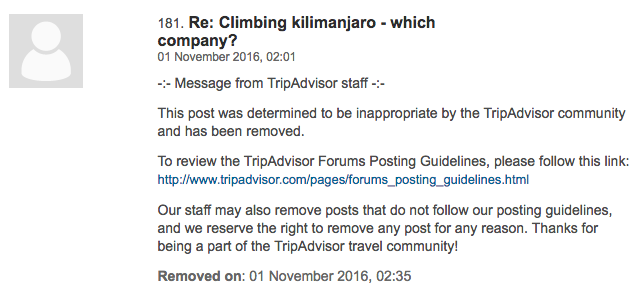
TripAdvisor deletion of inappropriate posts
2) Many operators bribe tourists to remove negative reviews or upgrade them
Unfortunately, being inappropriate is not the only reason why posts are getting removed on forums like TripAdvisor. As Henry Stedman warns on his Climb Mount Kilimanjaro website, many poor quality operators are bribing tourists to remove negative reviews, or to upgrade them.
I assume this also is the reason why you will find so many more positive than negative reviews on TripAdvisor and elsewhere. To find what can go wrong, you will need to dig a little deeper and browse also through older reviews.
3) Lots of social media is manipulative and controlled by unidentified stakeholders
I was new to Twitter when I created the @KiliUncovered account in May 2016 in order to increase transparency. It wouldn’t take me long to learn a lesson—social media can be more manipulative than informative! Let me illustrate by way of an example:
@TanzaniaRetweet is a Twitter account that is “retweeting all things #Tanzania … also #Kilimanjaro”. I got to know about them because—true to their mission—they retweeted even my very first posts, just because I mentioned #Kilimanjaro. Why is that important? Because the more people retweet you, the more visible you will be on Twitter.
After a bit of Twitter practice, I dared mention the word “#porter” in one of my tweets. Guess what?—No more retweets! They banned me for over a month. One day, they must have forgiven my #porter digression and started retweeting me again. By coincidence, that was also the time of Gugu Zulu’s tragic death on Kilimanjaro in July 2016, when there was lots of negative publicity. I felt that hype was over-exaggerated and reacted with positive news about high-quality local tour operators to put things back into perspective. So, perhaps, at that time their need for positive publicity was bigger than their dislike of my concern about porter treatment?
Then, however, I dared publish my book in August 2016. Since then, I seem to have been 100% banned from their retweets. Why? Because I didn’t allow myself to be corrupted by bribery, because I wasn’t shy to write the truth (to the best of my knowledge), or because the truth is not only shiny? Let’s face it: No country or tourist destination is perfect, and any book or review being 100% positive wouldn’t be credible. Just that some destinations are more receptive and open to feedback than others.
This leaves me wondering—is my book really revealing such shocking news that they need to ban me? Is my book the only truthful one (meaning not only not lying, but also not omitting unpleasant facts) that has been written about Kilimanjaro? And who is actually controlling that mysterious @TanzaniaRetweet account that everyone related to Tanzania seems to be following, but no one knows who stands behind?
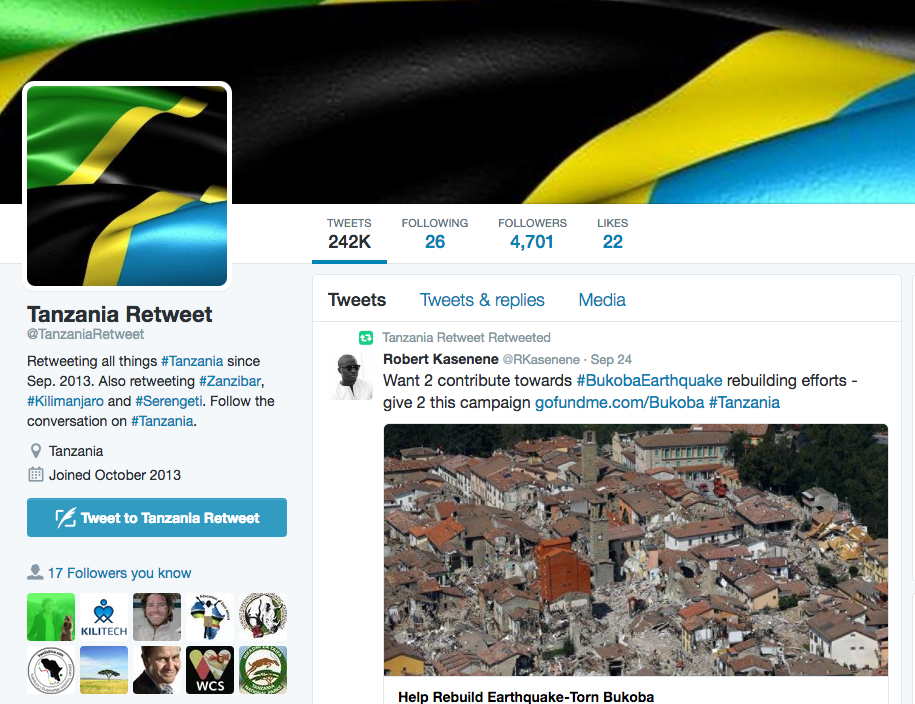
@TanzaniaRetweet Twitter account
Sorry @TanzaniaRetweet for picking on your example. I know you are not the only one and just following normal market practice, unfortunately.
4) Many bloggers don’t conduct proper research and outsource to cheap poor quality content writers
This reason—the business model behind online blogging—took me the longest to find out about. What you need to know is that blogging is big business, the most successful bloggers outsource to cheap content writers, and re-packaging information written by cheap content writers in a nice format doesn’t make it any more valuable.
Only now that I’m thinking of becoming an online entrepreneur myself—precisely to do something about the poor quality of Kilimanjaro information and the difficulty of organizing a climb—I’ve started experimenting with online content writers. So far, the quality of content I have received is either so poor that I have to discard it outright, or so barely acceptable that I have to spend significant time re-writing it. Obviously, unless someone is fully dedicated and obsessed with Kilimanjaro, like in my rare case, that effort wouldn’t be worthwhile.
Most bloggers and content writers are pressed for time and money. So what happens is that content writers quickly copy content from other online sources and repackage it into their own article. And then the bloggers who source content from those cheap writers spread their articles without checking the quality or verifying the sources. In the end, it’s the volume of content—no matter the quality—that drives traffic to their blogs.
That way, information gets copied over and over again, even though the initial sources may be long outdated or simply wrong. Then, because that information is spread all over the Internet, it is widely considered to be true even though it’s total nonsense. The same model, by the way, not only applies to Kilimanjaro but presumably most online content.
Worst of all, that wide-spread—but nevertheless untrue—content then gets picked up by established news channels which further increases its perceived truthfulness amongst an even wider audience. I have seen obvious nonsense about Kilimanjaro climbs published by CNN, redbull.com, the NZZ (Switzerland’s most reputable newspaper) and many more supposedly credible sources.
To give you a simple example: The number of Kilimanjaro tourists per year has long exceeded 50,000, and is now estimated at around 60,000 per year. Yet I can count the number of sources that get that right, or even just report anything more than 35,000, on the fingers of one hand.
5) The biggest Kilimanjaro guidebook publishers and website authors run their own climbing operations
This last reason—limited independence—is not to discredit any of those helpful sources. I highly respect their work, dedicated efforts and high-quality content. This includes people like Henry Stedman, the author of the indisputable #1 Kilimanjaro guidebook; Mark Whitman, the author of another guidebook and the very insightful blog climbkilimanjaroguide.com; or high-quality operators with helpful and informative websites such as ultimatekilimanjaro.com.
I think all of them, and many more, have done a tremendous job to increase transparency and help climbers—independent of the operators they end up choosing—with their organization and preparation, including myself.
However, operating in Tanzania means that they also have to play by the local rules. So, even if they wish to give you all information they have and be 100% transparent, they will have to think twice before spreading any negative information, naming particularly bad operators, or being critical of any government-linked authorities, including the Kilimanjaro National Park. For example, you will note that while Henry Stedman warns of fake online reviews, he does not include the names of those operators who are—unofficially—so well known for bribery and worse practices.
In my book, I mention a few of those bad examples by name, based on my own experience. Local insiders warned me that I should be careful because they might sue me. My reaction: “Let them sue me. Then at least I have proof of their poor practices and can spread it all over the Internet.” So far, unfortunately, they haven’t done so.
However, when operating locally with your own guide company, you don’t have the luxury of my “brutal honesty”, as some of my book reviewers commented.
By the way, all of this is just my personal opinion, and I have not discussed it with any of the above names.
Fortunately, there are also many credible sources and content contributors
By writing this article, I hope to make future Kilimanjaro climbers more aware of potential pitfalls. However, I certainly do not mean to discredit the valuable contributions made by those authentic folks who deserve a lot of credit for their good work, just that it’s not so easy to separate the wheat from the chaff. Amongst the most valuable sources—many of whom have also helped me with my own climbing preparations—I highly applaud the following:
1) All the book, video and website authors and creators that I’ve included under resources on this blog.
2) All the real tourists who have shared their experience on TripAdvisor and other forums, and not allowed themselves to be bribed.
3) All the bloggers who have written about their own Kilimanjaro experience and used good care and judgement when copying other sources.
4) All the responsible operators who provide high-quality content and abstain from overly misleading marketing (like ultimatekilimanjaro.com).
5) Henry Steman’s Climb Mount Kilimanjaro and Mark Whitman’s Climb Kilimanjaro Guide
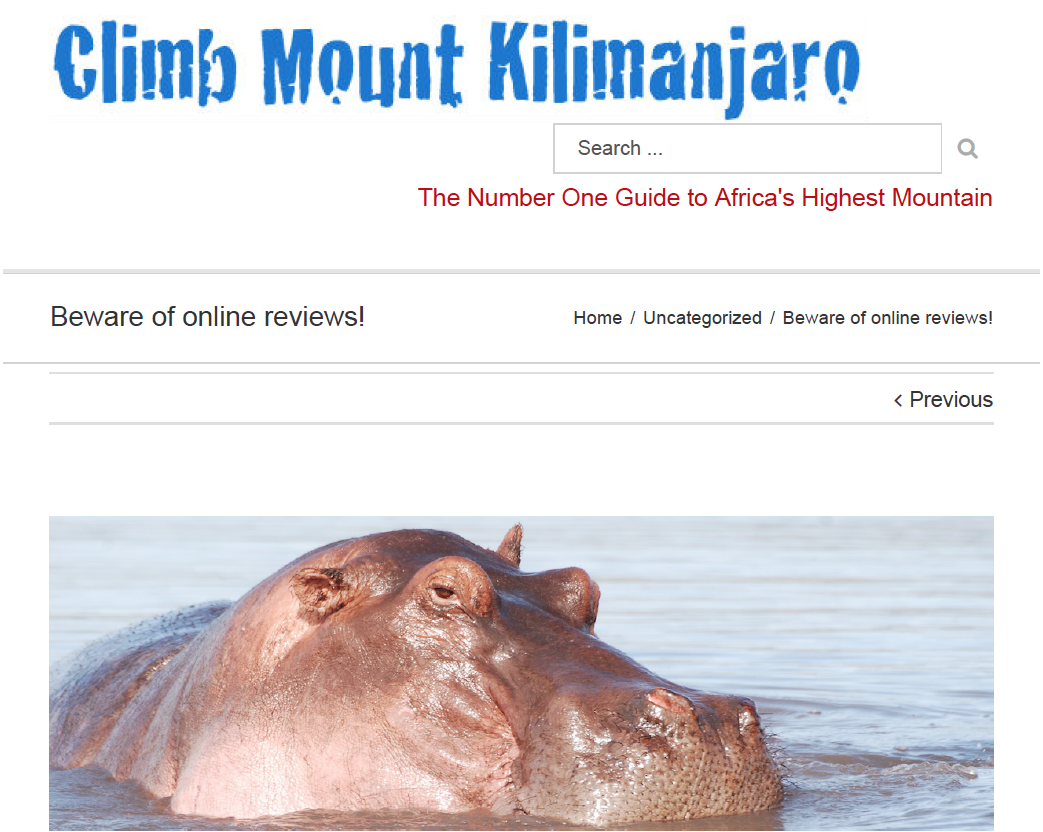

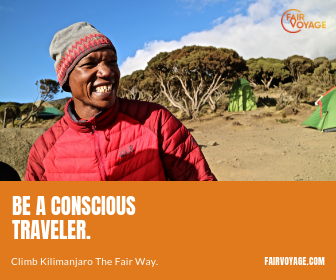



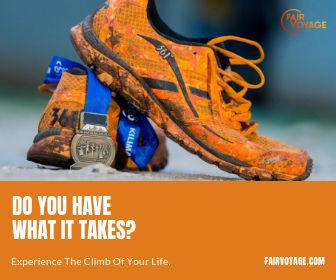
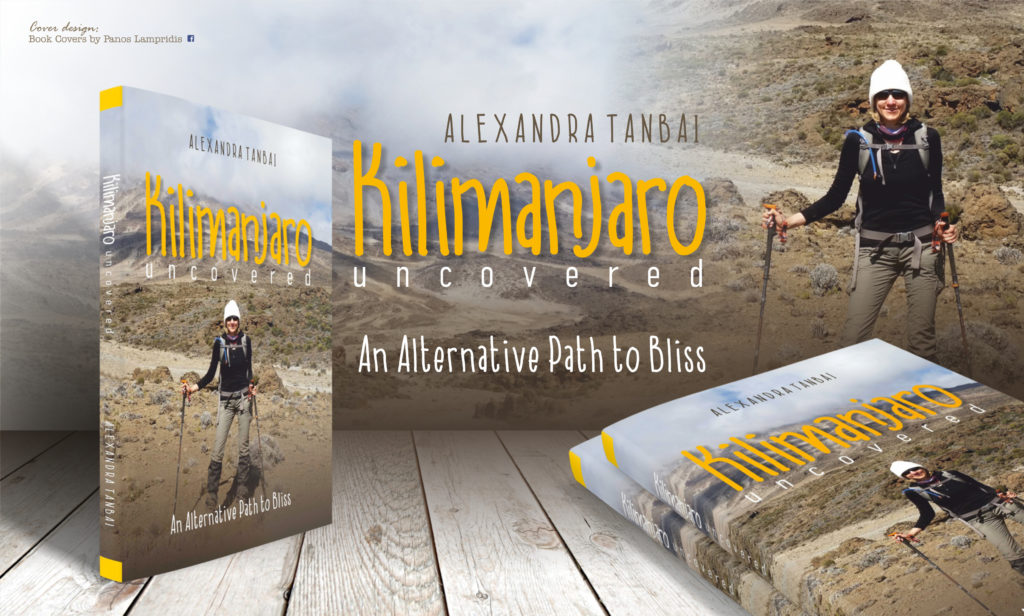
Leave a Reply